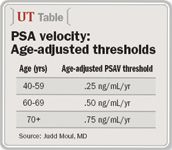Article
PSA velocity a useful, but imperfect treatment guide
San Francisco--An increase in the rate of PSA rise is bad news forpatients, but just how bad remains unclear. A series of trialsunveiled at the 2006 Prostate Cancer Symposium point to PSAvelocity, or PSAV, as a prognostic tool that is useful, but thathas some limitations.
San Francisco-An increase in the rate of PSA rise is bad news for patients, but just how bad remains unclear. A series of trials unveiled at the 2006 Prostate Cancer Symposium point to PSA velocity, or PSAV, as a prognostic tool that is useful, but that has some limitations.

"Prostatitis can be a confounder in the undiagnosed patient," he cautioned. "PSAV greater than 3.0 ng/mL per year is associated with a 25% to 100% greater likelihood of prostatitis. At such elevated levels, detecting prostatitis is as likely as detecting prostate cancer."

"A rapid increase in PSA warrants attention, not panic," Dr. Eggener said. "If you see a patient with a sudden and dramatic elevation in PSA, prostatitis may be as likely as cancer. Repeating the PSA is important to confirm the newly elevated value."
Other studies of PSAV were less equivocal. Judd Moul, MD, chief of urologic surgery at Duke University Medical Center, Durham, NC, analyzed a cohort of 11,347 men who had PSA tests at Duke between 1988 and 2005. Researchers found that age-normalized PSAV is more sensitive than traditional PSAV for detecting prostate cancer.
A PSAV of 0.75 ng/mL per year is traditionally considered high and worrisome for all men, Dr. Moul said. But because younger men have a greater life expectancy, he hypothesized that detection thresholds should be lower. Setting a threshold value of 0.25 ng/mL per year for men ages 40 to 59 years, 0.50 ng/mL per year for ages 60 to 69 years, and the traditional 0.75 ng/mL per year for 70 years and above improved prostate cancer detection. The lower values produced a detection rate of 35% in the youngest group and 57% in the middle group compared with 19% and 25% using the traditional 0.75 standard.
Swedish researchers found that initial PSA level and PSAV during the 2 years following prostate cancer diagnosis are strongly predictive of aggressive disease. But these two factors alone cannot identify which patients most require treatment.
Researchers assessed 295 men with localized prostate cancer who were being observed as part of a watchful waiting study arm. Patients were followed for a mean of 7.8 years.
The risk of aggressive disease increased about 5% for every 2.0 ng/mL per year increase in initial PSA. Among men with higher PSAV, 21% developed metastatic disease or died within 6 years of diagnosis. That compared with 8% of men with lower PSAV.
Newsletter
Stay current with the latest urology news and practice-changing insights — sign up now for the essential updates every urologist needs.















